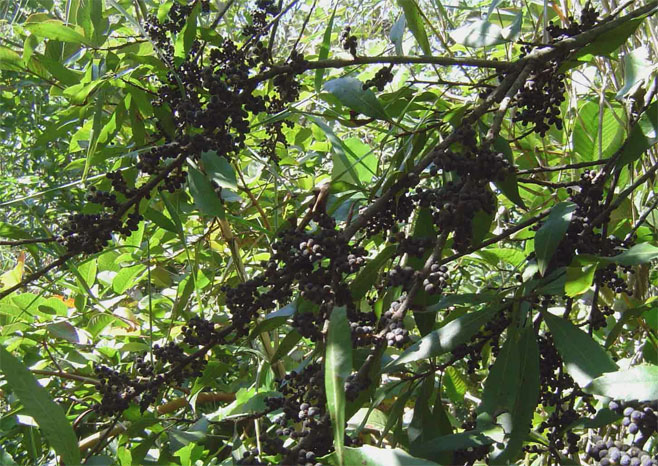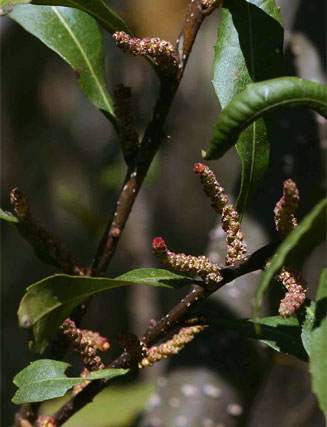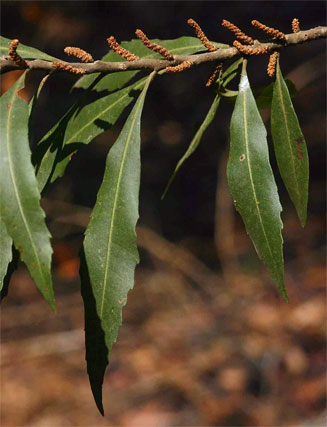Morella serrata (Lance-leaved waxberry)
[= Myrica serrata]
Smalblaarwasbessie [Afrikaans]
Life
> eukaryotes >
Archaeoplastida >
Chloroplastida
>
Charophyta > Streptophytina > Plantae (land plants)
> Tracheophyta (vascular plants) > Euphyllophyta > Lignophyta (woody plants)
> Spermatophyta (seed plants) > Angiospermae (flowering
plants) > Eudicotyledons > Core Eudicots > Rosids >
Eurosid I > Order: Fagales
> Family: Myricaceae > Genus:
Morella
 |
|
Morella serrata, Greystone Park Nature
Reserve, Harare, Zimbabwe. [photo Bart Wursten ©, Flora of Zimbabwe] |
 |
 |
|
Morella serrata, Greystone Park Nature
Reserve, Harare, Zimbabwe. [photo Bart Wursten ©, Flora of Zimbabwe] |
Morella serrata, Christon Bank, Zimbabwe. [photo
Bart Wursten ©, Flora of Zimbabwe] |
Identification
A shrub or small tree 3-4 m high. Leaves are
narrowly elliptic and quite long, usually about 10 cm long by 2 cm
wide but can reach 15 x 2.5 cm. Leaf margins are smooth or serrated
and rolled under. Leaves are net-veined, have golden yellow gland
dots on the lower surface (best viewed in bright light with
magnifying glass), and are aromatic. The young leaves are often
golden yellow, which contrasts in an attractive way with the
silver-coloured trunk (Palmer & Pitman 1972). Has
separate male and female flowers on the same plant or on separate
plants. Flowers are small and in short spikes. Fruit are small (3-4
mm in diameter), spherical and dark brown to black in colour, with a
waxy covering.
Distribution and habitat
Found in the Western Cape, Eastern Cape,
KwaZulu-Natal, Swaziland, Mpumalanga, Limpopo, Northwest Province
and Gauteng. Also occurs in eastern Zimbabwe and northern Botswana.
Grows along streams, on grassy hillsides and on forest fringes.
Phenology
Flowers from August to December.
Fruit have been recorded in October but
presumably occur later than that as well, judging from the flowering
dates.
Ecological interactions
Flowers are wind-pollinated according to Bean &
Johns (2005) or pollinated by bees according to Palmer & Pitman
(2002).
Has nitrogen-fixing nodules on the roots (Bean
& Johns 2005).
Uses
- The fruit, stems and leaves contain oils, which can be
extracted through boiling. The oil contains fatty acids, 9% of
which are saturated (Palgrave & Palgrave 2002). What is the oil
used for (if anything)?
- Fruits can be eaten but chewing the leaves causes an intense
burning at the back of the throat and in the nose and results in
a bad headache (Palgrave & Palgrave 2002).
Links
References
- Bean, A. and Johns, A. 2005. Stellenbosch to Hermanus - South African
Wild Flower Guide 5, including Kogelberg and Hottentots Holland.
Botanical Society of South Africa, Cape Town.
- Palgrave, K.C. and Palgrave, M.C. 2002. Trees of Southern Africa.
3rd Edition. Struik Publishers, Cape Town.
- Palmer, E. and Pitman, N. 1972. Trees of Southern Africa covering all
known indigenous species in the Republic of South Africa, South-West Africa,
Botswana, Lesotho and Swaziland. Volume 1. A.A. Balkema, Cape
Town.
Text by Hamish Robertson |
